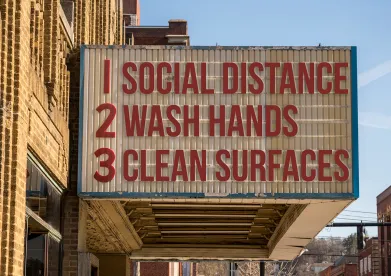When President Trump declared a national emergency due to the spread of COVID-19 on March 19, 2020, it activated eligible tribal, state, and local governments’ access to Federal Emergency Management Agency (FEMA) emergency funding. Tribes do not need a separate disaster declaration to gain access to FEMA funding, according to the FEMA Assistance for Tribal Governments fact sheet published March 26.
As of now, FEMA Public Assistance will provide 75 percent federal funds with the remaining 25 percent of eligible costs being the responsibility of the tribal government. This cost-sharing is the same regardless of whether the tribe receives public assistance as a direct recipient or a sub-recipient.
Tribes and Tribal organizations have sought modification of the cost-share requirement but, thus far, none have been granted. On April 20, the National Congress of American Indians (NCAI), Tribal organizations, and Tribal nations sent a letter to President Trump requesting a waiver of the cost-share waiver and adjustment of disaster funding and distributions for all federally recognized Tribal Nations, in which the federal funding would account for 100 percent of relief funding. According to FEMA’s Public Assistance Applicant Handbook this request is not unprecedented, stating, “when conditions warrant and if authorized by the President, 100 percent Federal funding may. . . be available for a limited period of time.”
The letter emphasized that Tribal nations are often unable to generate tax revenue the ways in which states generate revenue. Tribal nations rely on tribal enterprises to raise their government’s revenue, and these enterprises are closed to mitigate the spread of COVID-19. Thus, despite the funding technically being available, the cost-sharing is prohibitive for many tribes, as they do not have the revenue to account for even 25 percent of the costs to address their community’s increasing needs. The letter goes on to state that the federal government has a trust responsibility to assist Tribal nations, and the match requirement is inconsistent with this obligation.
However, even with the cost-sharing responsibility, FEMA remains a viable option for tribes struggling to meet the medical relief needs within their communities. With Coronavirus Relief Funds likely to soon be distributed by Treasury to Tribal governments, FEMA Public Assistance is an option to supplement the impact of those dollars. For tribes looking to optimize strategies for federal aid, we recommend reaching out to our Tribal Consulting Unit for advice.
This alert provides general information on how to procure FEMA funding, details on the Recipient and Sub-recipient process, and identifies activities that have been deemed eligible.
Tribal Government Public Assistance Access to FEMA Funding
Overview
Eligibility: Tribal Governments.
Process: Tribes may access FEMA Public Assistance funding either directly from FEMA as a recipient, or through the state government as a sub-recipient. The process for each is detailed below. FEMA Funding is provided on a cost-reimbursement basis, meaning that tribes first incur the costs, then seek reimbursement from FEMA. FEMA will not duplicate any assistance provided by the U.S. Department of Health and Human Services (HHS), the Centers of Disease Control and Prevention (CDC), or other federal agencies.
Administrative Costs: FEMA provides 7 percent of funds for administrative costs to recipients, but 5 percent for sub-recipients. This differential is intended to offset the greater administrative responsibilities of recipients, though the small amount may still make it advantageous for tribes to apply as sub-recipients.
Cost Sharing: As previously stated, FEMA Public Assistance will be provided at a 75 percent federal and 25 percent non-federal cost share. Tribal governments will be responsible for 25 percent of eligible costs. This is the same regardless of whether tribes receive public assistance as direct recipients or sub-recipients. However, some states may choose to share the 25 percent cost share with their sub-recipients to reduce financial burden on local and tribal governments.
Applying for Public Assistance through the Recipient and Sub-Recipient Processes
Recipient Process
As a recipient, a tribe receives funding directly from FEMA. Prior to receiving funding, as a tribal recipient you must:
-
Notify your FEMA Regional Tribal Liaison via email or letter (https://www.fema.gov/tribal-
contacts). -
Develop and execute the following required documents, plans, and agreements:
-
A FEMA-Tribe Agreement (FTA). FEMA Regional Liaisons will provide a draft agreement to Tribal governments for tribes to review, edit, and finalize for signature and distribution.
-
An emergency plan. A Tribal government must confirm activation of its emergency plan to receive assistance. FEMA regulations do not specify requirements for emergency plan content, only that a Tribal government must have a plan and the plan must be activated before requesting funding. (Read more from FEMA here).
-
A Public Assistance Administrative Plan. This plan outlines the roles and responsibilities of a tribe in administering Public Assistance. A template is available on the FEMA website and many Tribal governments likely already have such a plan due to their receipt of other federal funds.
-
Sub-Recipient Process
Tribes that are already working with a state government on collaborative responses might seek FEMA Public Assistance as a Sub-Recipient. To do so, Tribal governments must submit a Request for Public Assistance (RPA) to their appropriate state government agency by June 11, 2020. A standard RPA may be found at the following link: Request for Public Assistance (RPA). Tribal governments should coordinate directly with the appropriate state-level Office of Emergency Services.
Eligible Activities
FEMA describes reimbursable activities to include the following:[1]
-
Management, control and reduction of threats to public health and safety which includes Emergency Operation Center costs, training specific to the declared event, disinfection of eligible public facilities, and technical assistance to state, tribal, territorial or local governments on emergency management and control of immediate threats to public health and safety.
-
Emergency medical care which includes non-deferrable medical treatment of infected persons in a shelter or temporary medical facility; related medical facility services and supplies; use of specialized medical equipment; medical waste disposal; and emergency medical transport. It also includes temporary medical facilities and/or enhanced medical/hospital capacity (for treatment when existing facilities are reasonably forecasted to become overloaded in the near term and cannot accommodate the patient load or to quarantine potentially infected persons).
-
Medical sheltering, for example, when existing facilities are reasonably forecasted to become overloaded in the near future and cannot accommodate needs.
-
All sheltering must be conducted in accordance with standards and/or guidance approved HHS/ CDC and must be implemented in a manner that incorporates social distancing measures.
-
Non-congregate medical sheltering is subject to prior approval by FEMA and is limited to that which is reasonable and necessary to address the public health needs of the event, is pursuant to the direction of appropriate public health officials, and does not extend beyond the duration of the Public Health Emergency.
-
-
Household pet sheltering and containment actions related to household pets in accordance with CDC guidelines.
-
Purchase and distribution of food, water, ice, medicine, and other consumable supplies, including personal protective equipment, hazardous material suits, and movement of supplies and persons.
-
Security and law enforcement.
-
Communications of general health and safety information to the public.
-
Search and rescue to locate and recover members of the population requiring assistance.
-
Reimbursement for state, tribe, territory and/or local government workforce to account for overtime costs.
Utilizing FEMA Funding in Conjunction with Other Relief
Tribes and tribal entities are participating in a variety of relief programs from the impacts of this pandemic, including the Paycheck Protection Program (our practical tips for tribal governments can be found here), the Coronavirus Relief Fund (read about the new guidelines from Treasury related to this Fund here), Economic Injury Disaster Loan Emergency Advance (learn more about this loan advance program here), the Main Street Lending Program, and private insurance claims. FEMA funding is a useful tool for utilizing in conjunction with other programs and can provide significant assistance to meet the needs of medical facilities, food programs, public health, and security and law enforcement.




 />i
/>i

